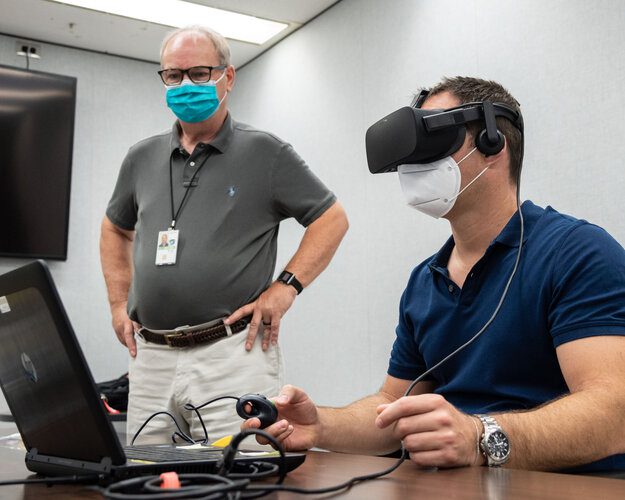
Image:
ESA astronaut Thomas Pesquet trains for the Time experiment at NASA’s Johnson Space Center in Houston, USA ahead of his Alpha mission to the International Space Station in 2021.
This European experiment on the International Space Station investigates the hypothesis that time subjectively speeds up in microgravity and was first run in space in 2017.
Whether an activity takes seconds or hours depends on your point of view. For astronauts living off-planet and experiencing roughly 16 sunrises and sunsets a day, the concept of time is even more warped. If astronauts float through space, do they also cruise through an altered sense of time?
Since perceptions of time and space are believed to share the same neural processes, and research on depth perception in weightlessness has shown that astronauts often underestimate distance, scientists speculate that for astronauts time also flies in space.
Thomas demonstrates the experiment perfectly in this image, wearing a virtual reality headset to block external visual cues that could influence results. While wearing this headset, astronauts are tasked with gauging how long a visual target appears before them and their reaction times to these prompts are recorded to process speed and attention.
The astronauts run the experiment before flight, on the International Space Station and again when they land to compare results.
Scientists are not only collecting data on the neurological mechanisms at work here. The relativity of time, after all, implies that it is all in your head. As much as we can objectively measure and plot time, how individual humans perceive it is not just neurological but also psychological.
This is an important factor to life both on and off Earth.
As home-like as the Space Station tries to be for its astronaut inhabitants, it still lacks many of the comforts that we know on Earth. Naturally, this can affect mental health and in turn astronauts’ cognitive abilities. Being alert and focused in space is crucial to safety. An astronaut misjudging time can delay reaction and risk the safety and success of crews and missions.
Understanding the neurological and psychological triggers that warp our sense of time means countermeasures can be developed to calibrate our mental clocks.
Bringing these countermeasures down to Earth could improve the lives of those who suffer from isolation or confinement, something of particular relevance during the current COVID-19 pandemic.
Check out this infographic for more on the Time experiment.
Comments are closed.